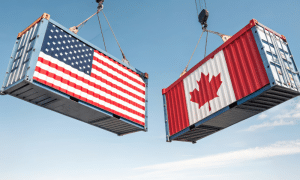
Today’s SOPA Fine Arts Blog will discuss the recent Tariff’s employed by the United States of America and detail how these tariffs may affect Canadian Art, Canadian Artist, and the Art Market as a whole. This article does not aim to embody any political stance but rather an educational piece for our readers. At this time, the current Tariffs will not effect current gallery operations. We thank you for your continued support.

Tariffs, Trade, and the Art Market: A Perfect Storm?

At first glance, tariffs on steel and aluminum may seem unrelated to the art world. But their ripple effects can be significant.

Artists who rely on imported materials—such as rare pigments, high-quality canvases, or sculpting metals—may see costs rise. Galleries and auction houses that import artwork from overseas could face higher tariffs on art and antiques, making international acquisitions more expensive. Logistics costs for transporting art may also climb due to broader trade restrictions, affecting collectors who buy and sell globally.

Currency fluctuations further complicate the situation. If tariffs and market instability weaken the U.S. dollar, foreign buyers might find American art more attractive, boosting domestic sales. Conversely, a stronger dollar could make imported artwork more expensive, potentially dampening enthusiasm for European and Asian art among U.S. collectors.
Edouard Gouin, who leads the art shipping and logistics company Convelio, warned that long-term tariff effects could disproportionately impact the art industry due to the U.S.’s dominant role in the market. He noted that tariffs would generally increase business costs, with galleries likely to be the hardest hit.
Who Bears the Cost of Art Tariffs?
For large businesses, the responsibility for paying tariffs falls on the U.S. importer, who typically passes the additional cost onto consumers through higher prices. When it comes to artwork, however, the buyer is often the importer, meaning collectors could face a 25% price increase.
The Impact on International Galleries
Galleries in Canada and Mexico may struggle to attract American buyers if tariffs raise the cost of artwork. Since art is already a significant investment, an additional 25% expense could deter collectors, leading them to shift their focus away from international pieces.
Where Wealthy Investors Are Putting Their Money—and Why It Matters for the Art Market

Wealthy investors are focusing on traditional long-term assets like real estate and private equity, with historically low allocations to cash—similar to levels seen just before the 2007 financial crisis.
This could signal confidence in the economy or serve as a warning sign, as overconfidence has historically preceded market corrections. The art world is paying close attention. While fine art remains a favored alternative asset, it competes for capital with real estate, private equity, and stocks. If investors allocate more to traditional assets, speculative art investments may slow. Emerging artists and contemporary markets could face headwinds, while blue-chip artists may remain attractive as a hedge against inflation.
Adapting to a New Reality: What Artists, Dealers, and Collectors Can Do

- Diversify Sales Channels and Markets Strengthening domestic and regional markets can help counter international trade uncertainties. Digital platforms, NFTs, and fractional art ownership models may also provide new opportunities.
- Optimize Supply Chains and Logistics Sourcing materials locally can help mitigate tariff-related cost increases. Dealers should negotiate better shipping and insurance terms and consider bonded warehouses or freeports to defer import taxes.
- Align with Changing Investor Sentiment Positioning fine art as a stable long-term investment can attract capital. Comparing art to real estate or private equity may make it more appealing to high-net-worth individuals.
- Stay Ahead of Regulatory Changes New tariffs, taxation policies, and import/export rules could reshape art transactions. Working with customs brokers and legal advisors is crucial to staying compliant.
This Article is for entertainment & Education purposes and is not financial Advice **
March 4, 2025